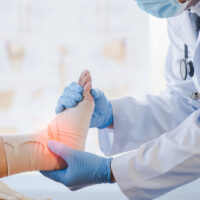Types of Injuries From a Trip and Fall

Trip and fall accidents are extremely common but no less dangerous for it. If you trip over an uneven floor, a loose wire, a cracked sidewalk, or some other hazard on someone else’s property, you have the right to seek compensation for any harm you’ve suffered as a result. Continue reading for a discussion of common trip and fall injuries in New York. If you’ve been hurt in a New York trip and fall, slip and fall, or any other type of accident, call a savvy NYC trip and fall attorney at the law office of Leandros A. Vrionedes, P.C.
How Does a Trip and Fall Accident Cause Injury?
Trip and fall accidents occur when a person catches their foot on an object while walking forward and is unable to get their other foot out in front before they succumb to a fall. Victims can trip over a discarded object, a loose wire, an uneven floor, or other hazards. Sidewalk trip and fall accidents commonly involve cracked sidewalks, broken sidewalks, uneven sidewalks, and other hazards caused by poor sidewalk maintenance.
Unlike slip and fall accidents, trips and falls usually send the victim falling forward, often at a high rate of speed. The victim might have the presence of mind to throw their hands out in front of them, which can cause impact injuries to the hands, elbows, shoulders, and other extremities. If the fall happens too suddenly, the victim can hit the ground or other objects head-first.
As a result of the nature of trip and fall incidents, the most common trip and fall injuries include the following:
Head and Brain Trauma
Many trip and fall victims hit their heads on the ground or other solid objects on the way down. Trauma to the head can lead to serious brain damage. Even a minor traumatic brain injury (TBI), such as a concussion, can impact your normal functioning for days or weeks.
If you identify symptoms such as blurry vision, memory loss, confusion, speech impediments, loss of consciousness, or nausea and vomiting, see a doctor immediately; you might have more severe brain damage. These symptoms can appear in the days or weeks following the accident, so make sure to remain alert and see a doctor if you identify anything unusual after striking your head.
Broken or Fractured Bones
If the fall victim manages to get their hands out in front to brace for the fall, injury is still likely to occur. The victim may suffer breaks or fractures to the wrist, elbow, or shoulder, as well as damage to the fingers, arms, and other bones. Fall victims often suffer a hip fracture and knee damage as well, depending on how they fall.
If the victim hits their head, they could suffer a broken nose, a broken orbital bone (eye socket), head fracture, and other serious damage. Broken and fractured bones can become even more severe if left untreated.
Soft Tissue Injuries
Trip and fall accidents often twist, bend, and otherwise contort your body into extreme, unusual positions. Many trip and fall victims suffer damage to the muscles, nerves, tendons, and ligaments, including sprains, strains, and tears. Ankle and wrist sprains are common, as are shoulder and knee strains, sprains, and tears. Torn ligaments and nerve damage can require surgeries and other long-term treatments for any hope of complete recovery.
Soft tissue injuries might not be detectable immediately after an accident, and they can manifest as pain, stiffness, numbness, or limited range of mobility in the days or weeks following an accident. Make sure to see a doctor after a trip and fall in case of hidden or latent injuries.
Shoulder and Rotator Cuff Injury
Trip and fall incidents often cause severe impact to the hands or shoulders, depending upon how the victim falls. Traumatic impact, violent twisting, or overextension of the shoulder can lead to a variety of shoulder and rotator cuff injuries. Victims may suffer from a dislocated shoulder, a torn rotator cuff, and other painful and debilitating injuries. Such injuries can take months or longer to heal, leaving the victim incapacitated for an extended period.
Neck and Spinal Cord Injury
Depending on how the victim falls, they can suffer damage to their neck or upper back. A sudden twist or traumatic impact can lead to neck or spinal cord injury. Broken vertebrae, herniated discs, muscle strains and tears, hyperextension, and other injuries are common.
Neck injuries and spinal cord injuries can be extremely severe, leading to long-term pain, functional limitations, and other long-lasting problems.
Dedicated Advice and Representation for Your New York Trip and Fall Case
If you or someone you care about has been seriously hurt in a New York City trip and fall, slip and fall, or other incident on someone else’s property, find out if you’re entitled to monetary damages for your injuries by contacting the zealous and successful New York premises liability lawyer Leandros A. Vrionedes for a free consultation at 212-889-9362.


